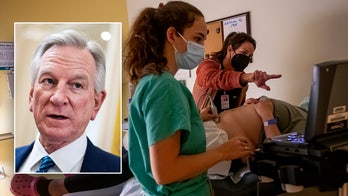This is the fifth in a series of posts, one year after the surge of unaccompanied undocumented minors who crossed across the U.S.-Mexico border, examining the effects it has had on communities, schools and children themselves.
MEXICO CITY – On a recent trip to La Patrona, a rural town surrounded by sugar cane plantations in Mexico's eastern state of Veracruz, Fox News Latino met with Las Patronas, a group of women who have dedicated themselves to helping Central American migrants travelling through the region on their way to the United States.
Every day they take posts near the railroad tracks with packages of food and blankets. When the rusty freight train aptly nicknamed “La Bestia” (“The Beast”) rushes by, the women toss the bags to migrants hitching a ride on the roof as they travel north.
These days, however, work at the tracks isn't as busy as it used to be.
“There just aren't that many people climbing the train anymore,” Norma Romero, founder of Las Patronas, told FNL. “There used to be hundreds of migrants on every train — so many we often didn't have enough packages to give them. But now there are only a handful, and often the train carries none at all.”
The trip, which is more than 1,100 miles just through Mexico, is a dangerous one. In their attempt to escape poverty, unemployment and rampant criminal violence, the migrants brave hunger, fatigue and cold, often face criminal gangs preying upon them.
The sight of freight trains cruising through Mexico with few or even no people on the roof is welcome news to its northern neighbor. Last year, U.S. authorities were scrambling to handle an unprecedented wave of undocumented migrants who crossed the border – a crisis made especially severe because of the many thousands of unaccompanied minors making their way to American soil.
Even as new detention centers opened and deportations sped up, the Obama administration began pressuring Mexico and Central American countries to lend a hand in solving the crisis.
Mexican President Enrique Peña Nieto and his Guatemalan counterpart, Otto Pérez Molina, reacted last July by enacting a comprehensive package of measures aimed at stemming the flow of migrants at Mexico’s southern border with Guatemala, the Programa Frontera Sur.
The plan, at least on paper, focuses mostly on ramping up security. New checkpoints were set up along highways in southern states such as Chiapas, and patrols searching for undocumented Central Americans have increased in number and intensity.
Part of that includes police and immigration officials trying to prevent migrants from boarding freight trains headed north.
The Frontera Sur Program also aims to combat human trafficking, organized crime and human rights violations in the border area, as well as making it easier for Guatemalan and Belizean workers to obtain a Regional Visitor Card, which allows a legal three-day stay to work in Mexico's four southernmost states.
At first blush, the effort appears to be bearing fruit. According to a recent report by the Washington Office on Latin America (WOLA), a D.C.-based NGO, Mexican deportations of undocumented Central Americans have spiked to unprecedented levels.
In 2014, 107,814 migrants were deported, the vast majority from Central America. And in the first two months of 2015, more than 25,000 were sent back to their countries of origin, a whopping 95 percent increase in comparison to the same period a year before.
Meanwhile, child migrant deportations from Mexico have increased so much they are now almost on par with U.S. statistics, and shelters in Mexico now report far less Central American visitors than in previous years.
Only a year ago, the migrant house in Saltillo, 190 miles from the Texas border in Mexico's northern state of Coahuila, received 300 migrants per night. That number has dropped to 80 at most, with sometimes as few as 20 visitors seeking shelter. Other shelters report similar drops.
Both Mexican and U.S. authorities consider the spike in deportations to be a sign of success.
In January, President Barack Obama praised Peña Nieto, saying, “In part because of strong efforts by Mexico, including at its southern border, we’ve seen those numbers [of migrants] reduced back to much more manageable levels.”
Not everybody agrees. In April, a number of migrant shelters and activist organizations including the MMM got together to form the Collective of Migrants and Refugees Defenders (Codemire). Together, they demanded that the Mexican government abandon Programa Frontera Sur.
“The plan is working, but not the way we'd like it to,” Martha Sánchez, president of the Mesoamerican Migrant Movement (MMM), told FNL. “What's working is the repressive part, the part that increases deportations and allows human rights violations to escalate.”
Activists say that Mexican authorities are lagging behind on the implementation of humanitarian components of the plan, which are intended to help keep migrants from making the journey , and have instead focused only on the detain-and-deport side.
“By preventing them from getting on the freight train, migrants are forced to take alternative routes to the U.S., which makes them far more vulnerable to criminal gangs,” Sánchez told FNL. “At the same time, we see many more reports of human-rights violations.”
Activists also criticize what they call the “myth” that the Programa Frontera Sur is only focused on Mexico's southern border.
“It applies to the all of the corridors used by Central American migrants,” Alberto Xicoténcatl, director of the Saltillo Migrant House, told FNL. "What we have seen is a joining of the Federal Police, SEDENA (the Secretariat of National Defense) and the National Immigration Institute to detain migrants. These detentions are massive."
Central American countries presented their own plan to deal with the migration crisis in September of last year. Dubbed the "The Plan of the Alliance for Prosperity in the Northern Triangle," it focuses mostly on economic development, job creation and strengthening institutions to combat the principal causes of migration in the region: poverty, unemployment and rampant violence.
The plan, though praised by some critics, has yielded no tangible results so far.
Meanwhile, violence and poverty keeps pushing migrants north.
Even as the murder rate in Honduras, the highest in the world, appears to have inched down in recent months, a failed truce between El Salvador's two largest criminal gangs has caused violence there to spike.
With more than 600 homicides, May was the deadliest month in that country in a decade.
“I have seen no sign that people are any less willing to go to the United States,” Rosa Nelly Santos, who heads Cofamipro, a migrant organization in the Honduran city of El Progreso, told Fox News Latino. “Employment, crime and poverty are as high as ever here. If that doesn't change, no amount of deportations can stop it.”
Includes reporting by David Agren in Saltillo, Mexico.
READ PART 1: Tens of thousands of immigrant children remain in limbo
READ PART 2: As crisis overwhelms system, philanthropy steps in
READ PART 3: Courts backlogged until 2019 to accommodate minors
READ PART 4: New U.S. policies have led to less children crossing




